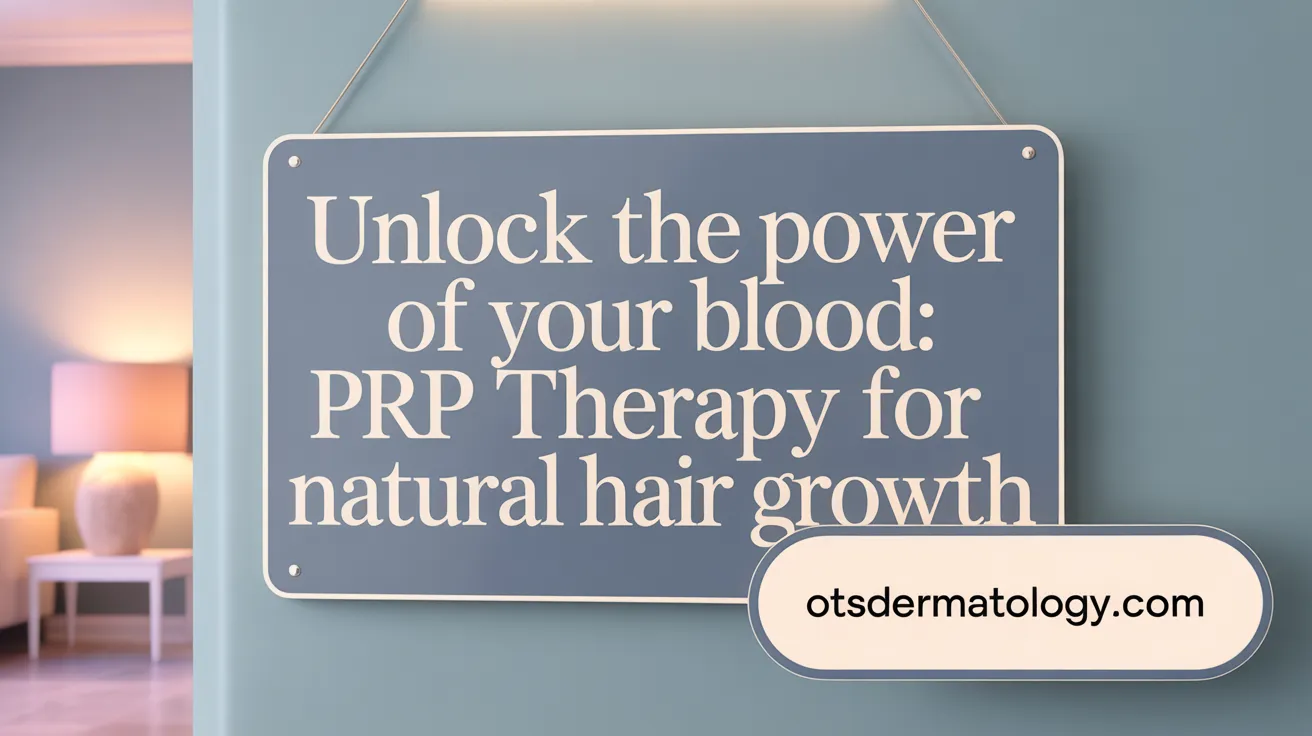Introduction to Modern Hair Restoration
Hair loss affects an estimated half of all men and millions of women worldwide, impacting confidence and quality of life. Advances in science and technology have transformed hair restoration from a primarily surgical domain to a multifaceted field incorporating regenerative medicine, minimally invasive techniques, and innovative therapies. This article explores two prominent hair restoration methods today — Platelet-Rich Plasma (PRP) therapy and advanced hair transplantation techniques — highlighting how each approach revitalizes hair growth and offers hope to those facing hair thinning and balding.
Key Facts on PRP Therapy and Advanced Hair Transplant Techniques
- PRP therapy uses patient's own blood concentrated for growth factors that stimulate hair follicles.
- Ideal PRP candidates are those with early to moderate hair thinning and dormant hair follicles.
- Typical PRP protocol involves three sessions spaced about one month apart, with maintenance every 6-12 months.
- PRP is a minimally invasive procedure with low risk of infection and minimal discomfort or downtime.
- PRP can be combined with medications, microneedling, and hair transplants to enhance results.
- PRP therapy generally costs between $400 to $2,500 per session with ongoing expenses for maintenance.
- Growth factors like FGF, VEGF, EGF in PRP promote cell proliferation and neovascularization in hair follicles.
- Main types of hair transplants today include FUE, which is minimally invasive, and FUT, involving a scalp strip.
- Advancements like robotic assistance (ARTAS) improve precision, reduce human error, and support natural hairline outcomes.
- Emerging technologies such as hair cloning, stem cell therapy, and exosome treatments aim to regenerate follicles and enhance scalp health.
1. Platelet-Rich Plasma (PRP) Therapy: Harnessing the Body’s Natural Growth Factors

What is PRP therapy and how does it stimulate hair growth?
Platelet-Rich Plasma (PRP) therapy is a cutting-edge, non-surgical treatment for hair loss that utilizes the patient's own blood. In this process, blood is drawn and placed in a centrifuge to concentrate platelets, which contain growth factors such as PDGF, VEGF, and EGF. These growth factors play a crucial role in stimulating dormant hair follicles, promoting scalp health, and encouraging thicker, stronger hair growth. PRP extends the anagen (growth) phase of hair follicles and improves microcirculation around the follicles, leading to enhanced hair density. For more information, see Platelet-Rich Plasma (PRP) therapy for hair growth and PRP for thicker hair.
Who is an ideal candidate for PRP treatment?
PRP therapy is best suited for individuals experiencing early to moderate hair thinning, particularly those with androgenetic alopecia or recent hair loss. It is most effective when hair follicles are dormant but not entirely dead; thus, it cannot regenerate hair in completely bald areas. Good overall health and realistic expectations also factor into candidacy. It tends to be more beneficial when used early in the hair loss process. For guidance, see PRP suitability for hair thinning and Ideal candidates for PRP.
What does a typical PRP treatment regimen look like?
The usual PRP treatment protocol involves an initial series of three sessions spaced about one month apart. Maintenance or booster treatments are often recommended every six to twelve months to sustain the results. Patients commonly notice improvements in hair density and thickness within three to six months following the first treatment series, with maximum results visible around one year with ongoing care. For detailed protocols, refer to PRP treatment schedule and PRP treatment timeline.
How safe and invasive is the PRP procedure?
PRP therapy is minimally invasive and typically completed in less than an hour with little discomfort. Since the treatment uses autologous blood, the risk of infection or allergic reaction is extremely low. Common side effects are generally mild and may include brief pain, redness, swelling, or bruising at the injection sites. There is minimal to no downtime associated with the procedure, allowing patients to resume normal activities quickly. Detailed safety information can be found at Safety and side effects of PRP therapy and Safety of PRP injections.
Can PRP be combined with other hair restoration methods?
Yes, PRP is often integrated into comprehensive hair loss treatment plans. It can be combined with FDA-approved medications like minoxidil and finasteride to enhance follicle stimulation. Additionally, PRP is frequently used alongside microneedling and hair transplantation procedures to support graft survival, improve scalp healing, and extend the benefits of hair regrowth therapies. Learn more about combination treatments at PRP combined with other hair loss treatments and PRP and hair transplant support.
What are the financial considerations of PRP therapy?
The cost of PRP therapy varies considerably, typically ranging from approximately $400 to $2,500 per session. Factors influencing price include equipment quality, clinic expertise, and geographic location. Insurance usually does not cover PRP as it is considered an elective cosmetic treatment. This financial aspect is important for patients to consider, especially as multiple sessions and ongoing maintenance treatments are required for optimal results. For financial details, see Cost of PRP treatment and PRP therapy price range.
Growth factors and biological mechanisms
The growth factors released by platelets in PRP, including fibroblast growth factor (FGF), vascular endothelial growth factor (VEGF), and epidermal growth factor (EGF), activate cellular proliferation in hair follicles. They stimulate stem cells in the bulge area of follicles and promote neovascularization, improving blood supply and follicle nourishment. PRP also increases epidermal thickness and follicular cell proliferation, which contribute to enhanced hair growth and follicle health. Learn more about PRP growth factors and mechanisms and PRP and hair follicle cell proliferation.
Common protocols and maintenance
Treatment generally starts with three sessions at 4- to 6-week intervals, followed by maintenance injections every 6 to 12 months. These regular booster treatments help sustain the therapeutic effects, as discontinuing PRP often leads to gradual loss of the newly grown hair. The overall regimen is customized based on patient response and the degree of hair loss. For more on protocols, see PRP treatment protocol and Maintenance PRP treatments.
Side effects and risks
Side effects from PRP therapy are typically minor, including scalp tenderness, mild swelling, bruising, or redness. Serious complications are rare due to the autologous nature of the treatment. However, factors such as the use of certain medications (like NSAIDs), smoking, or underlying health issues could increase risks. Proper patient evaluation and professional administration are essential to minimize adverse effects. For comprehensive risk information, see Side effects of PRP therapy and Safety and risks of PRP therapy.
2. Advanced Hair Transplant Techniques: FUE, Robotic Assistance, and the Future

What are the main types of hair transplant surgeries today?
Hair transplantation today primarily involves two techniques: Follicular Unit Extraction (FUE) and Follicular Unit Transplantation (FUT). FUE is a minimally invasive method where individual hair follicles are extracted directly from the donor area, typically the back or sides of the scalp. This approach results in minimal scarring with tiny dot-like marks and allows for a quicker recovery period. FUT, on the other hand, involves surgically removing a strip of scalp from the donor site, from which follicular units are dissected and transplanted. FUT usually leaves a linear scar and entails a longer recovery phase.
How has technology enhanced hair transplant precision and outcomes?
Technological advancements have significantly improved the precision and success rates of hair transplants. Robotic systems like the ARTAS iX system incorporate artificial intelligence and 3D imaging to map scalp characteristics precisely, selecting the best hair follicles for extraction and optimizing recipient site creation. These AI-assisted procedures allow customized treatment plans and shorten surgical time, resulting in natural-looking hairlines and faster recovery. Robotic assistance also reduces human error and surgical fatigue, thereby increasing graft survival rates.
What are the details of the surgical procedure and recovery?
Hair transplant procedures are typically performed under local anesthesia in outpatient settings and last from four to eight hours depending on the extent of hair restoration required. In FUE, individual follicular units are harvested using very small punches and implanted into thinning or bald areas. FUT involves excising a scalp strip, dissecting it into follicular units under microscopes, and strategically transplanting these units.
Post-surgery, patients are advised to protect the scalp, manage pain with medications, and follow detailed aftercare instructions to minimize infection and promote healing. Most patients can resume normal activities within several days to a week. Hair shedding commonly occurs within the first few weeks post-transplant, with new hair growth becoming visible by three to four months. Full aesthetic improvements typically develop over six to twelve months, and some patients might require multiple sessions to address extensive hair loss. For more on hair transplant surgical procedure and postoperative care.
What are the key risks and post-operative care considerations?
Hair transplantation carries risks such as bleeding, infection, scarring, folliculitis (inflammation of hair follicles), and sometimes unnatural hair growth patterns or poor graft survival. Scarring after FUT is linear and more noticeable, whereas FUE usually results in smaller, less visible dot scars. Adherence to post-operative care—including scalp hygiene, avoiding strenuous activities, and protecting the area from sun exposure—is critical to optimize outcomes and minimize complications.
What emerging technologies show promise beyond traditional transplants?
Innovative hair restoration methods are evolving rapidly. Hair cloning aims to multiply healthy hair follicles in the laboratory for future transplantation, potentially overcoming donor hair limitations. Stem cell therapies, including adipose-derived and umbilical cord stem cells, are experimental approaches focused on regenerating hair follicles and enhancing scalp tissue regeneration.
Exosome treatments, involving growth factor-rich vesicles, show potential for stimulating dormant follicles and improving graft survival. Additionally, scalp micro-pigmentation (SMP) offers a non-surgical cosmetic solution by tattooing tiny hair follicle-like dots to create the illusion of density and cover thin areas. For more about cutting-edge hair restoration technologies.
What role do hair transplants play in comprehensive hair restoration?
Hair transplants remain the most reliable permanent solution for advanced or patterned hair loss, especially when non-surgical options have limited efficacy. They are often integrated into comprehensive treatment plans combining pharmaceutical therapies—like minoxidil and finasteride—and regenerative methods such as Platelet-Rich Plasma (PRP) therapy. Such multidisciplinary approaches help maintain transplanted hair, stimulate native follicle health, and slow further hair loss progression.
These cutting-edge practices are setting the stage for the future of hair restoration, enhancing patient satisfaction through precision techniques, reduced invasiveness, and longer-lasting results.
Conclusion: Personalizing Hair Restoration in the Modern Era
Hair loss poses emotional and social challenges, but modern advancements in hair restoration offer a diverse arsenal of solutions tailored to individual needs. PRP therapy provides a non-surgical, regenerative approach stimulating natural hair regrowth and supporting scalp health, especially effective in early hair loss. Meanwhile, advanced hair transplant techniques, enhanced through robotics and AI, deliver precise, permanent restoration with increasing naturalness and minimal invasiveness. Emerging innovations like stem cell therapy, exosome applications, and hair cloning herald a promising future for limitless restoration options. Ultimately, personalized protocols combining these therapies under expert guidance empower patients to reclaim confidence and a fuller head of hair, reflecting the exciting progress defining hair restoration today.
